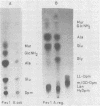Abstract
Peptidoglycan was purified from the oral bacterium Fusobacterium nucleatum strain Fev 1, using boiling sodium dodecyl sulfate and pronase. The composition of this peptidoglycan was found to be similar to that of other gram-negative bacteria, except that it lacked diaminopimelic acid. Lanthionine, the monosulfur analog of diaminopimelic acid, was identified as the diaminodicarboxylic acid of this peptidoglycan. It is assumed that lanthionine replaced diaminopimelic acid. Thus, the peptidoglycan of F. nucleatum Fev 1 is one of the few known sources of naturally occurring lanthionine.
Full text
PDF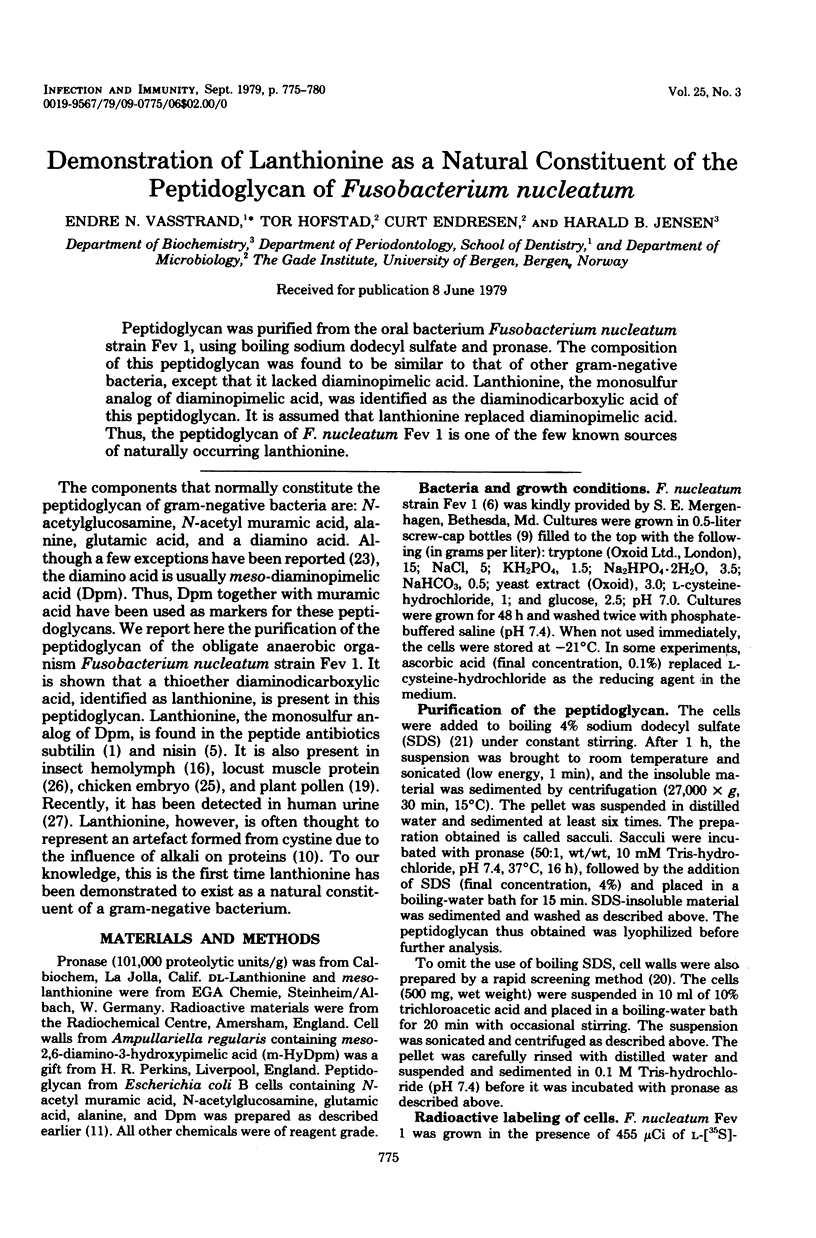
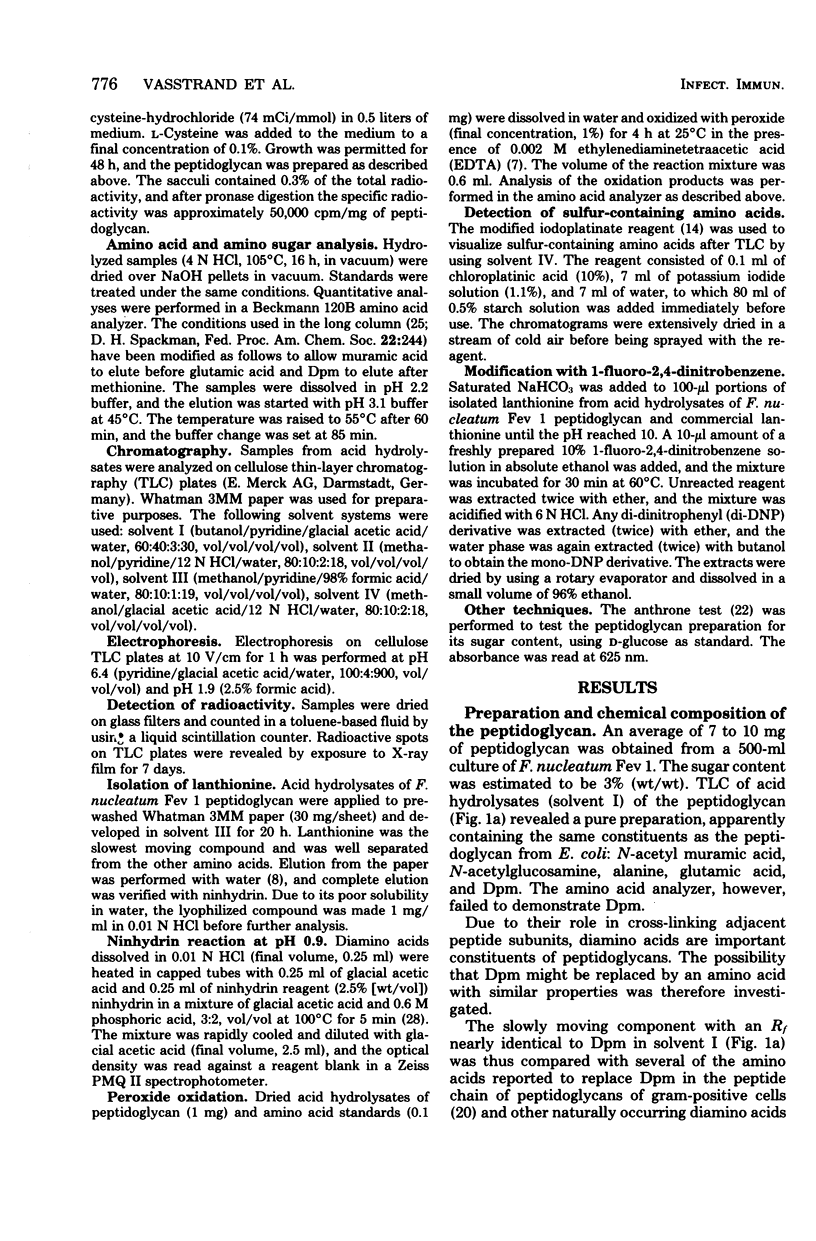
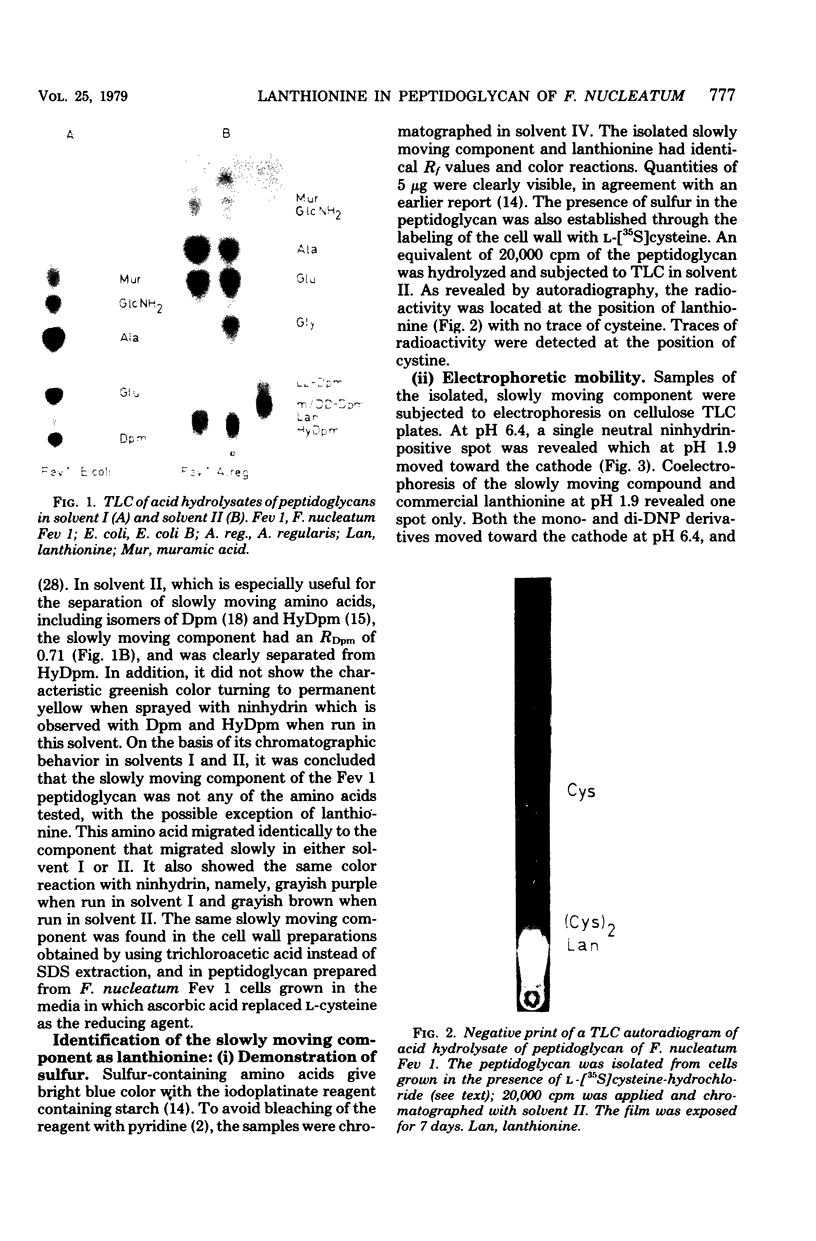
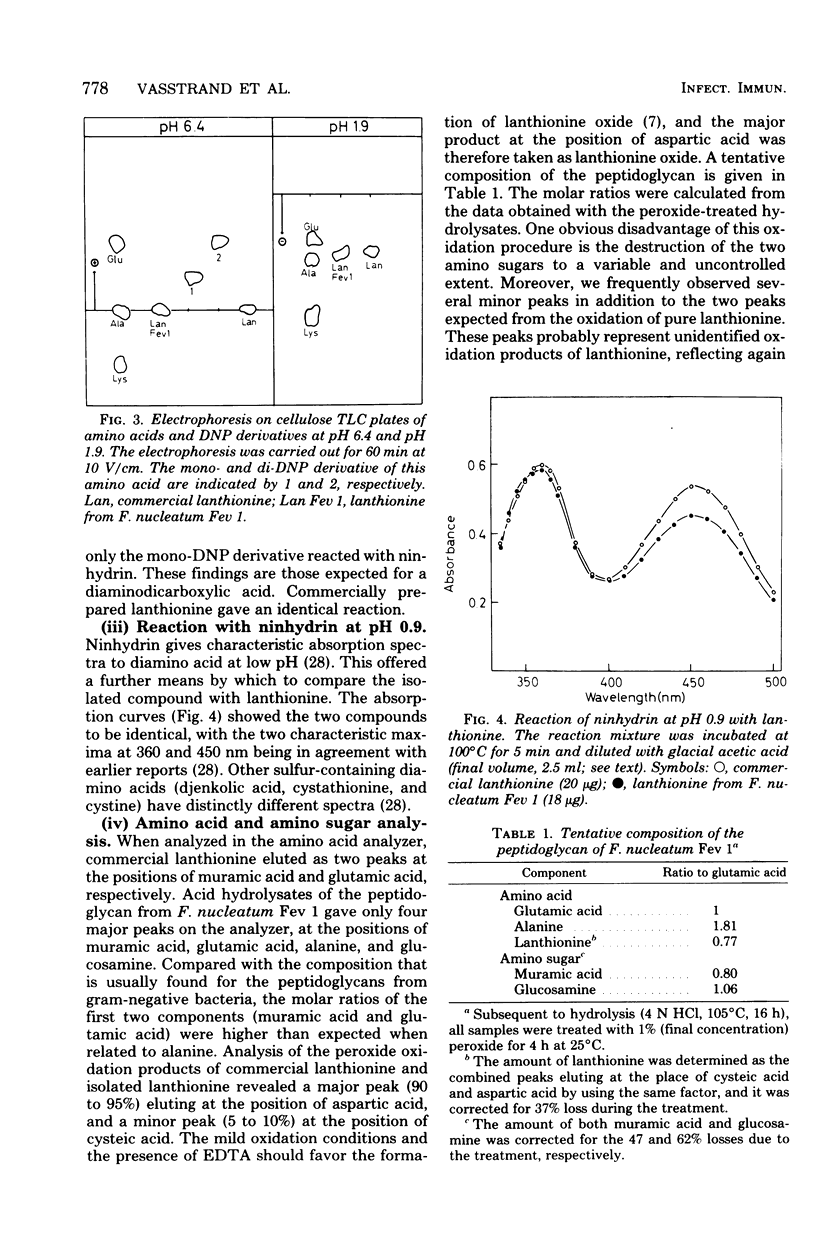
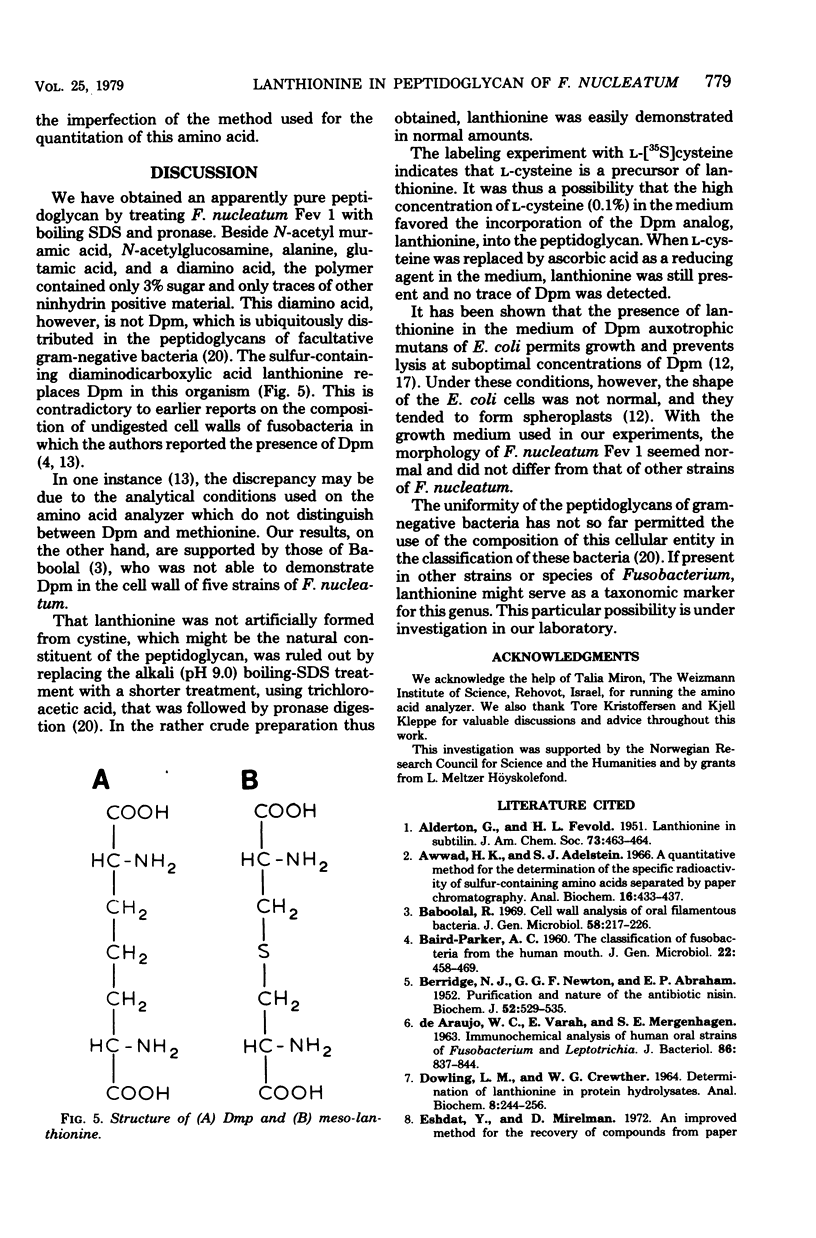
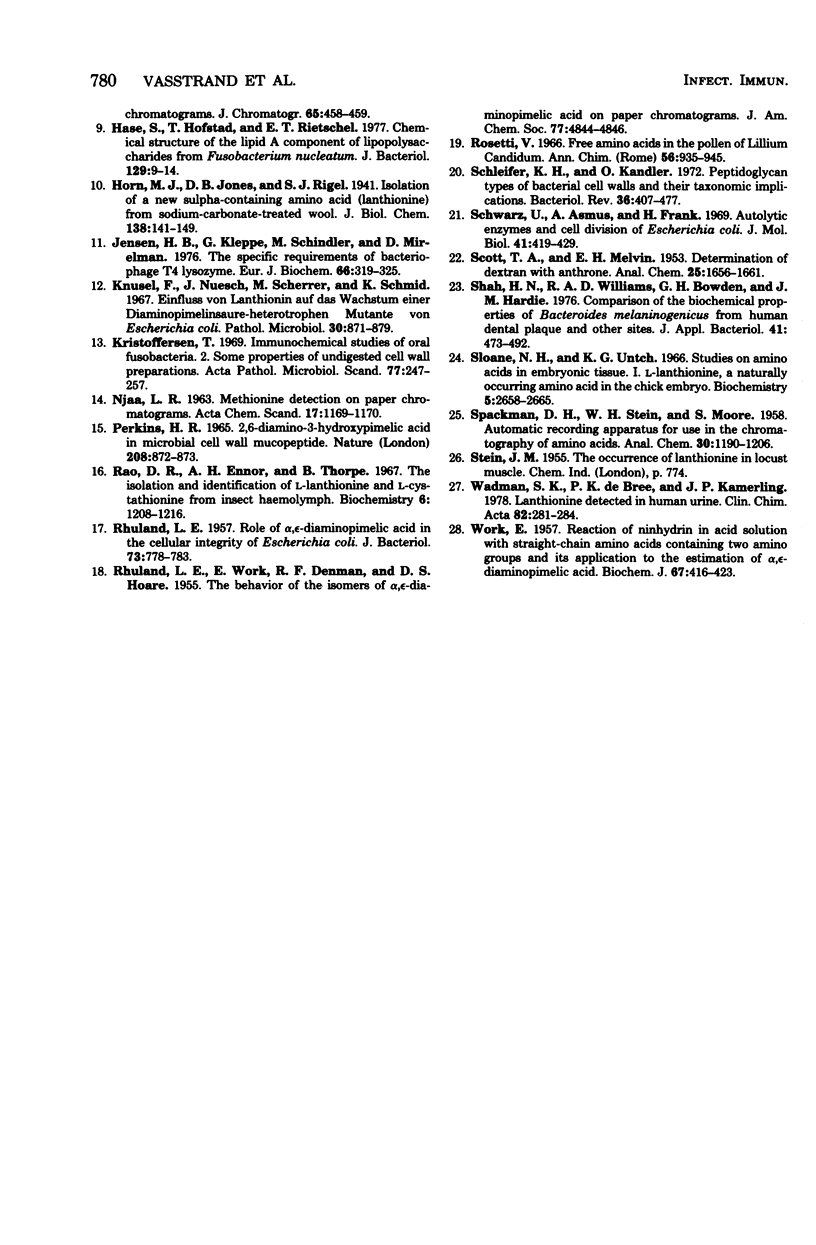
Images in this article
Selected References
These references are in PubMed. This may not be the complete list of references from this article.
- BAIRD-PARKER A. C. The classification of fusobacteria from the human mouth. J Gen Microbiol. 1960 Apr;22:458–469. doi: 10.1099/00221287-22-2-458. [DOI] [PubMed] [Google Scholar]
- BERRIDGE N. J., NEWTON G. G. F., ABRAHAM E. P. Purification and nature of the antibiotic nisin. Biochem J. 1952 Dec;52(4):529–535. doi: 10.1042/bj0520529. [DOI] [PMC free article] [PubMed] [Google Scholar]
- Baboolal R. Cell wall analysis of oral filamentous bacteria. J Gen Microbiol. 1969 Oct;58(2):217–226. doi: 10.1099/00221287-58-2-217. [DOI] [PubMed] [Google Scholar]
- DEARAUJO W. C., VARAH E., MERGENHAGEN S. E. IMMUNOCHEMICAL ANALYSIS OF HUMAN ORAL STRAINS OF FUSOBACTERIUM AND LEPTOTRICHIA. J Bacteriol. 1963 Oct;86:837–844. doi: 10.1128/jb.86.4.837-844.1963. [DOI] [PMC free article] [PubMed] [Google Scholar]
- DOWLING L. M., CREWTHER W. G. DETERMINATION OF LANTHIONINE IN PROTEIN HYDROLYZATES. Anal Biochem. 1964 Jun;8:244–256. doi: 10.1016/0003-2697(64)90052-1. [DOI] [PubMed] [Google Scholar]
- Hase S., Hofstad T., Rietschel E. T. Chemical structure of the lipid A component of lipopolysaccharides from Fusobacterium nucleatum. J Bacteriol. 1977 Jan;129(1):9–14. doi: 10.1128/jb.129.1.9-14.1977. [DOI] [PMC free article] [PubMed] [Google Scholar]
- Jensen H. B., Kleppe G., Schindler M., Mirelman D. The specificity requirements of bacteriophage T4 lysozyme. Eur J Biochem. 1976 Jul 1;66(2):319–325. doi: 10.1111/j.1432-1033.1976.tb10521.x. [DOI] [PubMed] [Google Scholar]
- Knüsel F., Nüesch J., Scherrer M., Schmid K. Einfluss von Lanthionin auf das Wachstum einer Diaminopimelinsäure-heterotrophen Mutante von Escherichia coli. Pathol Microbiol (Basel) 1967;30(6):871–879. [PubMed] [Google Scholar]
- Kristoffersen T. Immunochemical studies of oral Fusobacteria. 2. Some properties of undigested cell wall preparations. Acta Pathol Microbiol Scand. 1969;77(2):247–257. [PubMed] [Google Scholar]
- Perkins H. R. 2,6-Diamino-3-hydroxypimelic acid in microbial cell wall mucopeptide. Nature. 1965 Nov 27;208(5013):872–873. doi: 10.1038/208872a0. [DOI] [PubMed] [Google Scholar]
- RHULAND L. E. Role of alpha, epsilon-diaminopimelic acid in the cellular integrity of Escherichia coli. J Bacteriol. 1957 Jun;73(6):778–783. doi: 10.1128/jb.73.6.778-783.1957. [DOI] [PMC free article] [PubMed] [Google Scholar]
- Schleifer K. H., Kandler O. Peptidoglycan types of bacterial cell walls and their taxonomic implications. Bacteriol Rev. 1972 Dec;36(4):407–477. doi: 10.1128/br.36.4.407-477.1972. [DOI] [PMC free article] [PubMed] [Google Scholar]
- Schwarz U., Asmus A., Frank H. Autolytic enzymes and cell division of Escherichia coli. J Mol Biol. 1969 May 14;41(3):419–429. doi: 10.1016/0022-2836(69)90285-x. [DOI] [PubMed] [Google Scholar]
- Shah H. N., Williams R. A., Bowden G. H., Hardie J. M. Comparison of the biochemical properties of Bacteroides melaninogenicus from human dental plaque and other sites. J Appl Bacteriol. 1976 Dec;41(3):473–495. doi: 10.1111/j.1365-2672.1976.tb00660.x. [DOI] [PubMed] [Google Scholar]
- Sloane N. H., Unich K. G. Studies on amino acids in embryonic tissue. I. L-Lanthionine, a naturally occurring amino acid in the chick embryo. Biochemistry. 1966 Aug;5(8):2658–2665. doi: 10.1021/bi00872a026. [DOI] [PubMed] [Google Scholar]
- WORK E. Reaction of ninhydrin in acid solution with straight-chain amino acids containing two amino groups and its application to the estimation of alpha epsilon-diaminopimelic acid. Biochem J. 1957 Nov;67(3):416–423. doi: 10.1042/bj0670416. [DOI] [PMC free article] [PubMed] [Google Scholar]
- Wadman S. K., De Bree P. K., Kamerling J. P. Lanthionine detected in human urine. Clin Chim Acta. 1978 Jan 16;82(3):281–284. doi: 10.1016/0009-8981(78)90010-4. [DOI] [PubMed] [Google Scholar]



